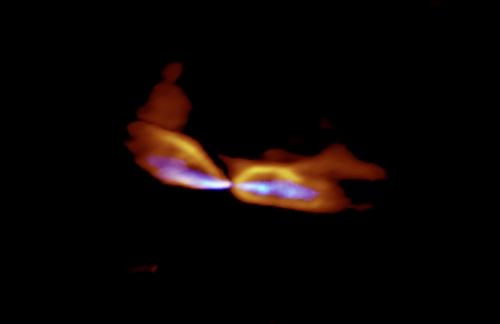研究成果 Research Results
- TOP
- News
- Research Results
- The Origin of Star’s Birth Cry
The Origin of Star’s Birth Cry
2019.02.26Research ResultsPhysics & Chemistry
In the early stage of star formation, the baby stars are crying. The first cry is identified as the mass ejection (outflow/jet) from the baby star. The low-velocity outflows are ubiquitously observed in star forming regions. These flows are also regarded as a key to understand the process of mass accumulation in the star formation process. A team of researchers from Kyushu University and National Astronomical Observatory of Japan observed a low-velocity outflow and high-velocity jet from the protostar (MMS5/OMC-3) using the Atacama Large Millimeter/submillimeter Array (ALMA). They found that these flows have misaligned axes, the high-velocity jet is not aligned with the low velocity outflow. In addition, their results indicate that the low-velocity outflow starts to be ejected earlier than the high-velocity jet.
Why do these two flows appear or what is the origin of their driving mechanism? Two controversial models (“the nested disk wind” and “entrainment” models) have proposed to explain the formation mechanism of both outflow and jet. In the nested wind model, two types of flow appear in different parts of the disk independently. On the other hand, in the entrainment model, the high-velocity jet is formed first, and then it entrains the surrounding gas to form the low-velocity outflow. The observed axis difference between the outflow and jet is a clear evidence of supporting the first scenario, “nested wind model”. Therefore, these two types of flow are launched in different parts of the disk around the protostar. These findings significantly contribute to understanding the star formation process.
This research was supported by JSPS KAKENHI (No. 17K05387, 17H06360, 17H02869, 15K05032) and Science Visitor Program of the Joint ALMA Observatory.
For more information, see https://doi.org/10.3847/1538-4357/aaf1b6, Matsushita et al. :“A Very Compact Extremely High Velocity Flow toward MMS 5/OMC-3 Revealed with ALMA” The Astrophysical Journal. (DOI: 10.3847/1538-4357/aaf1b6).
For details, see https://alma-telescope.jp/en/news/press/omc3-201902

Fig. 1. ALMA observation result. The orange color shows low-velocity outflow and the blue color shows high-velocity jet.
(Credit: ALMA (ESO/NAOJ/NRAO), Matsu-shita et al.).

Fig. 2. Schematic view of MMS5/OMC-3 (Credit: NAOJ).
Journal Reference
American Astronomical Society logo iop-2016.png A publishing partnership A Very Compact Extremely High Velocity Flow toward MMS 5/OMC-3 Revealed with ALMA, ,The Astrophysical Journal, 10.3847/1538-4357/aaf1b6Research-related inquiries
- TOP
- News
- Research Results
- The Origin of Star’s Birth Cry































